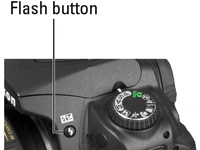Taking a great photo of a person takes more than point-and-shoot — even when they’re sitting still. In classic photography, a perfect portrait will keep the subject sharply focused while throwing the background into soft focus. This artistic choice emphasizes the subject and helps diminish the impact of any distracting background objects in cases where you can’t control the setting. Knowing how to take that perfect picture takes only a few simple steps.
>
>
>
1
Set the Mode dial to A (aperture-priority autoexposure) and select the lowest f-stop value possible.
>
Dialing in a low f-stop value is the first step in softening your portrait background. Also keep in mind that the farther your subject is from the background, the more blurring you can achieve. If you aren’t comfortable with this advanced exposure mode, Portrait mode also results in a more open aperture, although the exact f-stop setting is out of your control.
>
>
>
>
2
To further soften the background, zoom in, get closer, or both.
>
Zooming in to a longer focal length reduces depth of field, as does moving physically closer to your subject. Avoid using a lens with a short focal length (a wide-angle lens) for portraits. They can cause features to appear distorted — sort of like how people look when you view them through a security peephole in a door.
>
>
>
>
3
Select appropriate flash setting (off for indoor; on for outdoor) if possible.
>
For indoor portraits, shoot using available light rather than flash for softer illumination and no red-eye. In the A exposure mode, simply keeping the built-in flash unit closed disables the flash. In Portrait mode, hold the Flash button down as you rotate the main command dial to select the Off setting.
For outdoor portraits, use a flash if possible, which will add a beneficial pop of light to subjects’ faces. In the A exposure mode, you can just press the Flash button on the side of the camera to enable the flash. For daytime portraits, use the fill flash setting. (That’s the regular, basic flash mode.) For nighttime images, try red-eye reduction or slow-sync mode.
Unfortunately, Portrait mode uses Auto flash, and if the ambient light is very bright, the flash may not fire. Switch to an advanced exposure mode (P, S, A, or M) to regain flash control. But do note that whatever exposure mode you use, the top shutter speed available when you use the built-in flash is 1/200 second, so in extremely bright light, you may need to stop down the aperture to avoid overexposing the photo. Doing so, of course, brings the background into sharper focus. So try to move the subject into a shaded area instead.
>
>
>
>
4
Press and hold the shutter button halfway to initiate exposure metering and autofocusing.
>
Make sure that an active autofocus point falls over your subject. If you have trouble, simply set your lens to manual focus mode and then twist the focusing ring to set focus.
>
>
>
>
5
Press the shutter button the rest of the way.
>
This captures the image.
>
>
dummies
Source:http://www.dummies.com/how-to/content/how-to-shoot-still-portraits-with-a-nikon-d90.html


No comments:
Post a Comment